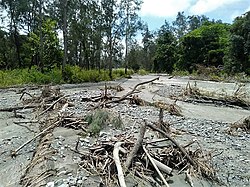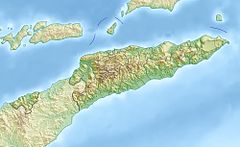| South Laclo River | |
|---|---|
 | |
| Native name |
|
| Location | |
| Country | East Timor |
| Municipality | Manufahi |
| Physical characteristics | |
| Source confluence | Ahangcain River |
| Mouth | Timor Sea |
• location | Uma Berloic / Dotik |
• coordinates | 9°07′44″S 125°56′55″E / 9.1289°S 125.9486°E |
| Basin size | ~ 216 km2 (83 sq mi) |
| Basin features | |
| Tributaries | |
| • left | Limetain River, Clerec River (branch) |
| • right | Marak River |
The South Laclo River (Portuguese: Ribeira de Lacló do Sul or Rio Lacló do Sul, Tetum: Mota Lakló) is a river in the Manufahi municipality of East Timor. It flows southwards, and then southeastwards, into the Timor Sea.
Etymology[edit]
English language sources conventionally refer to the river as the South Laclo River,[1][2][3] as there is also another Laclo River, usually referred to in English as the North Laclo River, which discharges into Wetar Strait on the north coast of East Timor.[1][2][4]
The North Laclo River takes its name from the town of Laclo, which is located on its left bank, about 13 km (8.1 mi) from its mouth.[5]
The two rivers are not connected to each other; both rise in the uplands near Turiscai in Manufahi municipality, where a drainage divide causes them to flow southwards and northwards, respectively, in each case later augmented by several tributaries.[3][4][6]
Course[edit]
The headwaters of the river are in the suco of Matorec, southeast of Turiscai, Manufahi. The river and its tributaries flow through Manufahi in a southerly and then southeasterly direction, until the river discharges into the Timor Sea at the southern tip of the border between Sucos Uma Berloic and Dotik.[7]
In order of entrance, the river's main tributaries are as follows:
- Limetain River: rises in Suco Matorec northeast of Oroluli; flows generally south southeastwards to just east of Lagoa Laheborak, where it merges with a stream discharging from that lake to form the Ahangcain River (see below).[7]
- Ahangcain River: flows from the confluence of the Limetain River and the stream discharging from Lagoa Laheborak southeastwards to the border between Turiscai and Fatuberlio administrative posts, near which it becomes the South Laclo River.[7][8]
- Marak River: rises at the border between Fatuberlio and Alas administrative posts; flows southeastwards, initially forming the border between Sucos Aituha and Taitudac to enter the South Laclo River near the border between Aituha and Dotik.[7][9]
- Clere or Clerec River: a branch of this river enters the South Laclo River a short distance north of the latter's mouth; the rest of it flows into swampy marshland that includes several lagoons.[7][10]
Catchment[edit]
The river's catchment or drainage basin is located within Manufahi municipality,[7] and is approximately 216 km2 (83 sq mi) in area.[11]: 2, 52 Its main population centre is the town of Alas in central Manufahi.[7]
East Timor has been broadly divided into twelve 'hydrologic units', groupings of climatologically and physiographically similar and adjacent river catchments.[11]: 2, 52 [12] The South Laclo River catchment is one of the four major catchments in the Clere & Be-Lulic hydrologic unit, which is about 1,923.6 km2 (742.7 sq mi) in total area; the others are the catchments of the Clere, Be-Lulic and Caraulun Rivers.[11]: 9, 52
Economy[edit]
The catchment is the main source of water for the sucos of Taitudac and Mahaquidan in its middle reaches, and Uma Berloic in its lowlands.[13]
In and prior to the 1940s, there was gold exploration on the banks of the river.[14]: 16 An academic paper published in 2014 asserted that there were prospects of finding gold placer in the sandy gravel strata in the South Laclo and two other rivers in the Turiscai administrative post, and, more importantly, of finding primary gold deposits in those rivers' upper reaches.[15]
See also[edit]
References[edit]
- ^ a b Garren, William R.; Peterson, Boyd D.; Page, Carl R. (September 1982). Gazetteer of Indonesia. Vol. I (A–L) (3rd ed.). Washington, DC: Defense Mapping Agency. p. 610.
- ^ a b ————————; ————————; —————— (September 1982). Gazetteer of Indonesia. Vol. II (N–Z) (3rd ed.). Washington, DC: Defense Mapping Agency. p. 857.
- ^ a b "South Laclo River, Manufahi District, Timor Leste". Mindat.org. Retrieved 10 June 2022.
- ^ a b "Laclo River, Timor Leste". Mindat.org. Retrieved 10 June 2022.
- ^ Esteves Felgas, Hélio A. (1956). Timor Português [Portuguese Timor]. Monografias dos territorios do ultramar (in Portuguese). Lisbon: Agência Geral do Ultramar, Divisão de Publicações e Biblioteca. OCLC 460341068.
- ^ de Sá, Artur (1952). "Capítulo I: Geografia Física" [Chapter I: Physical geography]. Timor (in Portuguese). Lisbon: Sociedade de Geografia de Lisboa. Semana do Ultramar. OCLC 491978170.
- ^ a b c d e f g República Democrática de Timor-Leste: Manufahi [Democratic Republic of Timor-Leste: Manufahi] (PDF) (Map). 1:75000 (in Portuguese). Cartography by Instituto Superior Técnico. Lisbon: Timor-Leste GIS Portal. Archived from the original (PDF) on 30 June 2007. Retrieved 18 July 2022.
- ^ "Mota Ahangcain, Manufahi, Timor Leste". Mindat.org. Retrieved 2 July 2022.
- ^ "Mota Marak, Manufahi, Timor Leste". Mindat.org. Retrieved 2 July 2022.
- ^ "Sungai Clerec, Manufahi, Timor Leste". Mindat.org. Retrieved 2 July 2022.
- ^ a b c Costin, Graham; Powell, Bronwyn (2006). Situation Analysis Report: Timor-Leste (PDF) (Report). Brisbane: International WaterCentre. Retrieved 6 July 2022.
- ^ AQUASTAT Country Profile – Timor-Leste (PDF) (Report). Rome: Food and Agriculture Organization of the United Nations (FAO). 2011. p. 4. Retrieved 25 June 2022.
- ^ Cofreros, Felipe (2019). East Timor: A New Independent Country. Bloomington, IN, USA: Trafford Publishing. p. 49. ISBN 9781490797700.
- ^ Ramos, Paula da Silva (2014). "Aspectos físicos do Timor Leste" [Physical aspects of East Timor] (PDF). PETGeo Informativo (in Portuguese). VIII (87). Santa Catarina State University: 4–28. ISSN 1982-517X.
- ^ Yang, X.-Z; Zeng, Y; Liu, J.-A; Chen, G.-G; Liu, C (March 2014). "An analysis of metal mineral resource potential and mining investment environment in East Timor". Geological Bulletin of China: 334-341. Retrieved 9 July 2022.
External links[edit]
![]() Media related to South Laclo River at Wikimedia Commons
Media related to South Laclo River at Wikimedia Commons
